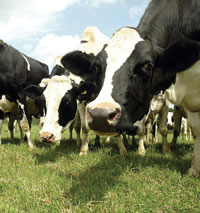NVZs – Dairy farms: Calculating the slurry storage requirement

The first step is to calculate the quantity of manure that the farm holding is generating, says Oliver Lee of consultant Andersons.
| You can find average rainfall for your area at www.metoffice.gov.uk |
|---|
For some producers this will be important, as better separation of parlour washings, gutter or yard run-off could dramatically reduce the quantity of slurry that has to be stored.
“Start by calculating the number of animals and the type of animals in your slurry system. Using the standard values in the DEFRA guidance booklet, calculate how much excreta is produced by each animal per month,” says Mr Lee.
“For instance, if there are 150 cows in a herd, over the October-February storage period, 130 will be in the system (assuming 20 are dry). Using the DEFRA values, that means 1.59cu m per animal, per month – so 206.7 cu m/month in total.”
But of that, what proportion will be collected as slurry? “If you’ve a cubicle system, then it’s probably everything. But on other systems, it might be only 80%, depending on whether some cows have access to straw yards. But regardless of how long they are in for, you must still have enough storage to meet the 22-week requirement,” says Mr Lee.
The total slurry produced per month, multiplied by the five months of the closed period, calculates the slurry that must be stored. But there are other factors too. For instance, if the slurry lagoon is uncovered, farmers need to include in their storage calculation the rainfall collected on the surface of the slurry lagoon.”
The same applies to rainfall draining into the store from the collecting yard, the concrete around the silage clamp, the clamp area itself – all these areas, multiplied by the average rainfall for the area, must be added to the overall volume of slurry produced. There are yet more details to consider – DEFRA has also included standard values for parlour washings. These must be added, too, if the eventually enter the slurry store. “It would be great if we could avoid this, but at them moment, few dairy units can,” says Mr Lee.
The situation gets more complicated if farmers are exporting any slurry – or importing it – as this affect the total storage requirement.
“So, adding together all those elements, set against the total volume of the current slurry store will determine whether there is a significant shortfall.”
Taking action
Farmers who find themselves with a storage deficit have a number of practical options, says Mr Lee. “The obvious one seems to be to invest in more expensive storage. But producers do have options. For instance there may be potential for better separation of dirty water or grey water, reducing the overall slurry volume. A farmer could also try to divert the water from parlour washings into a separate container away from the slurry store, and similarly, try to divert and collect the rainwater falling on the silage clamp and collecting yard.”
There’s probably no need to cover the yard, just to divert the run-off away from the slurry store, he says.
“But every dairy unit will be different, and storage calculations must be done by 30 April every year – for instance it must be reviewed if numbers on the holding increase. And care is needed – changing to a high-pressure hose could push parlour washings up significantly and make a real difference.”
Back to front page of guide
